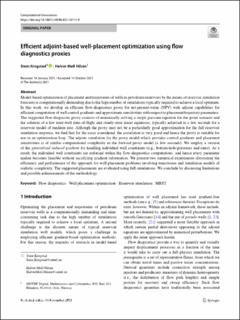| dc.contributor.author | Krogstad, Stein | |
| dc.contributor.author | Nilsen, Halvor Møll | |
| dc.date.accessioned | 2022-05-06T12:55:28Z | |
| dc.date.available | 2022-05-06T12:55:28Z | |
| dc.date.created | 2021-11-18T14:44:44Z | |
| dc.date.issued | 2021 | |
| dc.identifier.citation | Computational Geosciences. 2021. | en_US |
| dc.identifier.issn | 1420-0597 | |
| dc.identifier.uri | https://hdl.handle.net/11250/2994607 | |
| dc.description.abstract | Model-based optimization of placement and trajectories of wells in petroleum reservoirs by the means of reservoir simulation forecasts is computationally demanding due to the high number of simulations typically required to achieve a local optimum. In this work, we develop an efficient flow-diagnostics proxy for net-present-value (NPV) with adjoint capabilities for efficient computation of well control gradients and approximate sensitivities with respect to placement/trajectory parameters. The suggested flow-diagnostic proxy consists of numerically solving a single pressure equation for the given scenario and the solution of a few inter-well time-of-flight and steady-state tracer equations, typically achieved in a few seconds for a reservoir model of medium size. Although the proxy may not be a particularly good approximation for the full reservoir simulation response, we find that for the cases considered, the correlation is very good and hence the proxy is suitable for use in an optimization loop. The adjoint simulation for the proxy model which provides control gradients and placement sensitivities is of similar computational complexity as the forward proxy model (a few seconds). We employ a version of the generalized reduced gradient for handling individual well constraints (e.g., bottom-hole-pressures and rates). As a result, the individual well constraints are enforced within the flow-diagnostics computations, and hence every parameter update becomes feasible without sacrificing gradient information. We present two numerical experiments illustrating the efficiency and performance of the approach for well placement problems involving trajectories and simulation models of realistic complexity. The suggested placements are evaluated using full simulations. We conclude by discussing limitations and possible enhancements of the methodology. | en_US |
| dc.language.iso | eng | en_US |
| dc.publisher | Springer | en_US |
| dc.rights | Navngivelse 4.0 Internasjonal | * |
| dc.rights.uri | http://creativecommons.org/licenses/by/4.0/deed.no | * |
| dc.subject | Flow diagnostics | en_US |
| dc.subject | Well placement optimization | en_US |
| dc.subject | Reservoir simulation | en_US |
| dc.subject | MRST | en_US |
| dc.title | Efficient adjoint-based well-placement optimization using flow diagnostics proxies | en_US |
| dc.type | Peer reviewed | en_US |
| dc.type | Journal article | en_US |
| dc.description.version | publishedVersion | en_US |
| dc.rights.holder | © The Author(s) 2021. This article is licensed under a Creative Commons Attribution 4.0 International License, which permits use, sharing, adaptation, distribution and reproduction in any medium or format, as long as you give appropriate credit to the original author(s) and the source, provide a link to the Creative Commons licence, and indicate if changes were made. The images or other third party material in this article are included in the article's Creative Commons licence, unless indicated otherwise in a credit line to the material. If material is not included in the article's Creative Commons licence and your intended use is not permitted by statutory regulation or exceeds the permitted use, you will need to obtain permission directly from the copyright holder. To view a copy of this licence, visit http://creativecommons.org/licenses/by/4.0/. | en_US |
| dc.source.pagenumber | 14 | en_US |
| dc.source.journal | Computational Geosciences | en_US |
| dc.identifier.doi | 10.1007/s10596-021-10111-9 | |
| dc.identifier.cristin | 1956050 | |
| dc.relation.project | Norges forskningsråd: 280950 | en_US |
| cristin.ispublished | true | |
| cristin.fulltext | original | |
| cristin.qualitycode | 1 | |

